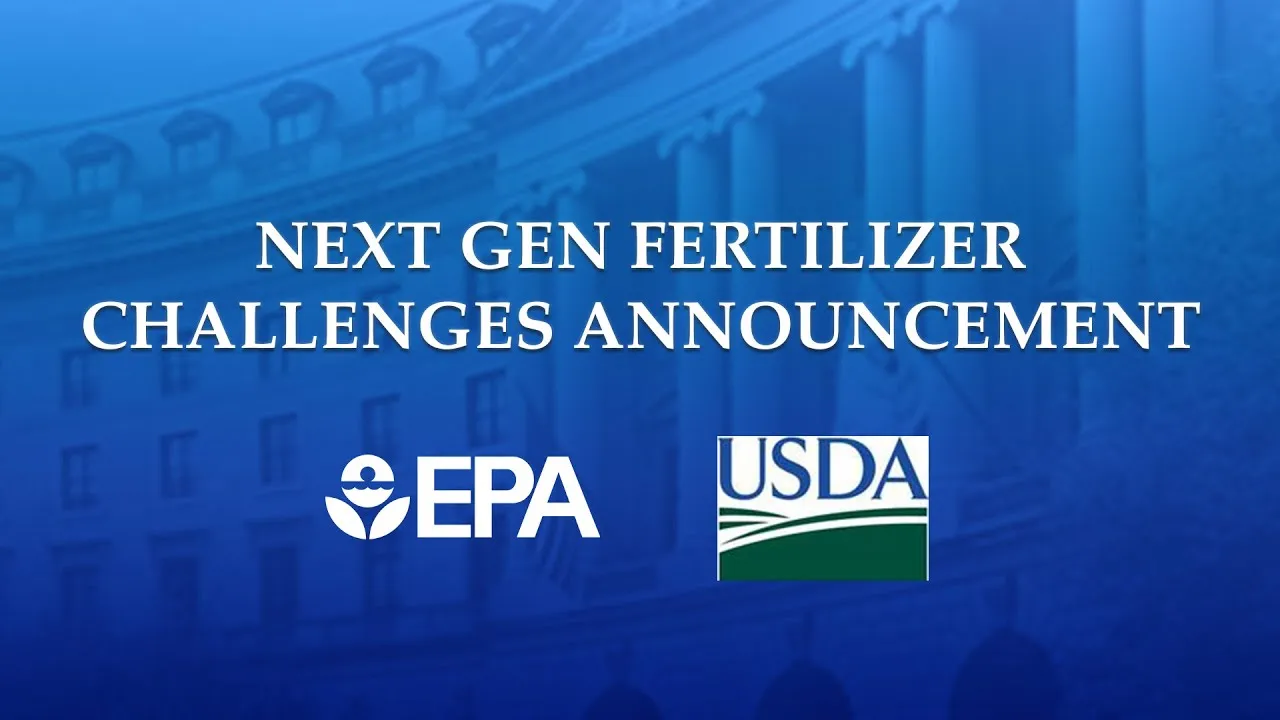


وزارة الزراعة الأمريكية ووكالة حماية البيئة تعلنان عن الفائزين في تحدي ابتكارات الجيل القادم للأسمدة
واشنطن، ١٩ أكتوبر ٢٠٢١ - أعلنت وزارة الزراعة الأمريكية ووكالة حماية البيئة الأمريكية اليوم عن الفائزين في تحدي ابتكارات الجيل القادم للأسمدة، وهو الجزء الثاني من شراكة ومسابقة مشتركة بين وزارة الزراعة الأمريكية ووكالة حماية البيئة الأمريكية حول الأسمدة المُحسَّنة الكفاءة (EEFs) لتعزيز الاستدامة الزراعية في الولايات المتحدة. تهدف المسابقة إلى تحسين كفاءة الأسمدة لزيادة غلة المحاصيل مع الحد من آثارها على البيئة.

قدّم الفائزون بالتحدي أفكارًا لتقنيات جديدة تُقلّل من الآثار البيئية للنيتروجين والفوسفور الناتجين عن الزراعة الحديثة، مع الحفاظ على إنتاجية المحاصيل أو زيادتها. تستخدم الحلول الفائزة جسيمات نانوية تتطلب سمادًا أقل، وتُطلق العناصر الغذائية عند الحاجة للنباتات النامية، ثم تتحلل بيولوجيًا إلى مواد غير ضارة، أو حتى مغذيات؛ وتُعزز نمو النباتات باستخدام نفس كمية الأسمدة أو كمية أقل؛ بالإضافة إلى أساليب أخرى.
“Farmers, ranchers, and foresters are well-positioned to be leaders in tackling climate change through technological innovation,” said Acting USDA Chief Scientist Hubert Hamer. “Through programs like the Next Gen Fertilizer Innovations Challenge, USDA is partnering with the private sector to find new climate-smart solutions that are good for farmers and good for the environment.”
“The goal of the challenge is to develop and use innovative and affordable technologies to reduce environmental impacts of modern agriculture on our air, land, and water, while maintaining agricultural productivity and profitability,” said Wayne Cascio, acting principal deputy assistant administrator for science for EPA’s Office of Research and Development. “We are excited about the possibilities and continued new work in this area.”
The winning concepts include a range of solutions that can improve environmental outcomes, including reduced nitrous oxide emissions—the largest source of greenhouse gas emissions from agriculture— while maintaining or increasing crop yields.
الفائزون هم:
الحلول من المستوى الأول (جائزة بقيمة 17,500 دولار):
الدكتور كريستوفر هندريكسون، من شركة Aqua-Yield Operations LLC، درابر، يوتا، لإنتاج سماد نانوي ذكي.
Taylor Pursell, Pursell Agri-Tech, Sylacauga, Ala., for “Urea 2.0,” which replaces the conventional urea core with a customizable mixture of materials to provide fertilizers tailored to local needs.
الحلول من المستوى 2 (جائزة 10000 دولار):
الدكتور كويدي تشين، من شركة فيرديسيان لايف ساينسز، كاري، كارولاينا الشمالية، لاستخدامه تقنيات الخلط المبتكرة لتحسين أداء النيترابيرين القياسي في الصناعة لتحقيق فعالية أطول، وتقليل تسرب النترات، ومنع تآكل المعدات الزراعية.
Dr. Catherine Roue, Fertinagro Biotech International, Portage, Mich., for “Phosphate Liberation Booster” technology, which uses secretions from phosphate-starved plants to boost plant uptake so less fertilizer may be added and legacy phosphorus can be accessed.
Chandrika Varadachari, Agtec Innovations Inc., Los Altos, Calif., for “Smart-N,” which is a smart-fertilizer that releases nutrients on-demand by the crop and which creates a chemical “cage” for urea that dissolves into plant nutrients.
حلول المستوى 3 (ذكر مشرف):
الدكتور ياروسلاف نيسلر، معهد علم النبات التجريبي، الأكاديمية التشيكية للعلوم، جمهورية التشيك، لاستخدامه مشتقات هرمون نمو النبات MTU، والذي يساعد على خلق فترات نمو أطول، والحماية من الإجهاد، والنباتات الأكبر، وفقدان أقل للمغذيات لكل وحدة من الأسمدة المطبقة.
Dr. Leanne Gilbertson, Civil and Environmental Engineering Department at the University of Pittsburgh, Penn., for creating a “protected fertilizer package,” which can carry nutrients through soil pores to the area around the plant roots.
Dr. Robert Neidermyer, Holganix LLC, Aston, Penn., for “Bio 800+,” a microbial inoculant that harnesses the power of over 800 species of soil microbes, kelp, and other soil amending ingredients to promote greater crop production and plant health.
Paul Mullins, Brandon Products Ltd., Ireland, for “BBS-1,” a biostimulant derived from seaweed extract that is applied as a fertilizer coating to improve nitrogen-uptake in root cells.
وتقوم وزارة الزراعة الأمريكية ووكالة حماية البيئة بتنسيق تحديات EEF مع معهد الأسمدة (TFI)، ومركز تطوير الأسمدة الدولي (IFDC)، ومنظمة الحفاظ على الطبيعة (TNC)، والرابطة الوطنية لمزارعي الذرة (NCGA).
The competition launched on August 26, 2020. Part two of the first challenge, “EEFs: Environmental and Agronomic Challenge,” is ongoing. More information can be found at: www.epa.gov/innovation/next-gen-fertilizer-challenges.
USDA touches the lives of all Americans each day in so many positive ways. In the Biden-Harris Administration, USDA is transforming America’s food system with a greater focus on more resilient local and regional food production, fairer markets for all producers, ensuring access to safe, healthy and nutritious food in all communities, building new markets and streams of income for farmers and producers using climate smart food and forestry practices, making historic investments in infrastructure and clean energy capabilities in rural America, and committing to equity across the Department by removing systemic barriers and building a workforce more representative of America. To learn more, visit www.usda.gov.
-
Zinc Chloride: a reliable stabilizer for ice dye color salts in the dye industryأخبارAug.11,2025
-
Propargyl Alcohol: A Multifunctional Chemical Additive in the Industrial FieldأخبارAug.11,2025
-
Phosphorus Pentasulfide: a special material that combines moisture absorption and basic chemical valueأخبارAug.11,2025
-
Natural Pesticides: The Environmental Choice for Green Prevention and ControlأخبارAug.11,2025
-
Grass Pesticide: the invisible guardian of green lawnsأخبارAug.11,2025
-
Dimethyl Sulfoxide: Key Assistance in Sample Management and Drug ScreeningأخبارAug.11,2025
-
Uncover the Benefits of Sodium ChlorateأخبارJun.24,2025


















